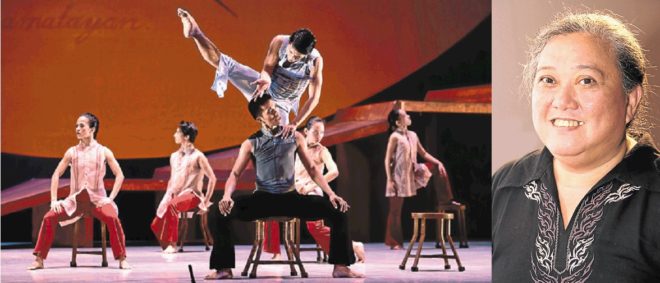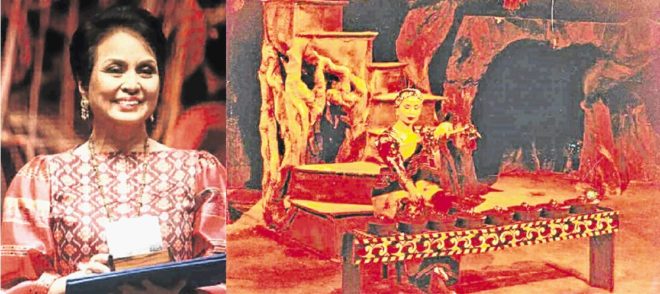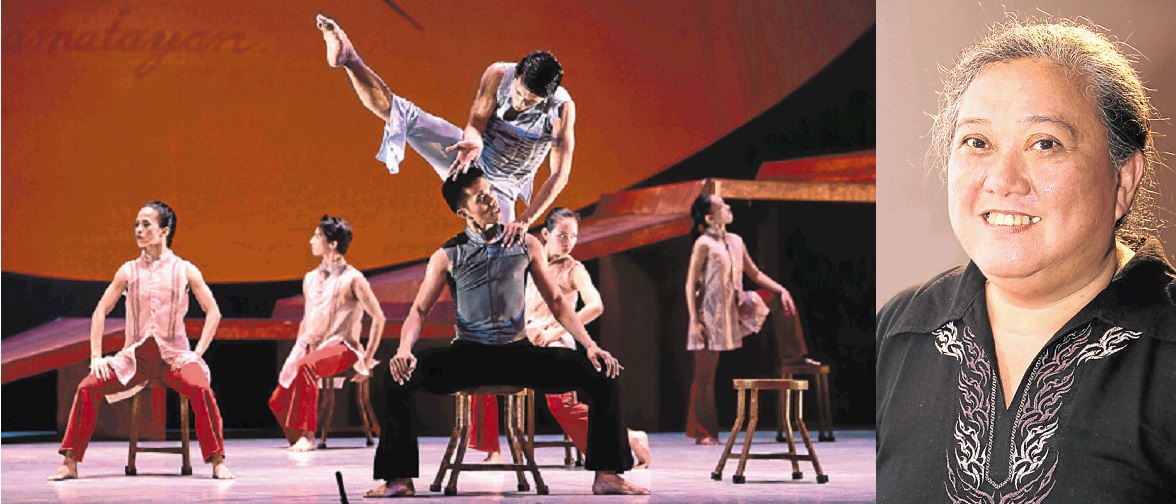
“Nakakahiya! Matanda na talaga ako.” (It’s embarrassing! I’m really old.) This was Agnes Locsin’s reaction when she was told she would be a recipient this year of the Natatanging Gawad Buhay, the lifetime achievement award presented by the board of the Philippine Legitimate Stage Artists Group (Philstage).
For Locsin, award ceremonies are stressful. “May acceptance speech pa!” (And there has to be an acceptance speech!) she added. It’s a lingering sentiment, even after she has received a raft of honors for her work as a choreographer and dance teacher, including the Gawad CCP para sa Sining in 2012 and Ateneo’s Gawad Tanghal ng Lahi in 2014.
(At the 10th Gawad Buhay held last Thursday at the CCP Little Theater, Locsin choreographed a dance piece for actor Nonie Buencamino as part of her acceptance “speech.”)
Great promise
Locsin completed an undergraduate degree in English at the Ateneo de Davao, but was cajoled by a brother into doing graduate work in dance at Ohio University. “I really wanted to be a dancer,” she said.
Back in Davao after her studies, she soon realized that a choreographer, rather than a dancer, was more needed since there were many more excellent dancers coming up who needed new works to perform. “I choreographed for everything, including debuts and Christmas parties,” she recalled her beginnings.
Locsin eventually began sharing her expertise in Manila, teaching at the University of the Philippines and other dance schools, and working in diverse productions for different companies. At the Philippine Educational Theater Association (Peta), she served as assistant choreographer to Denisa Reyes in “Diablos.”
“Even then, as a twenty-something-year-old, she already exhibited promise as a great choreographer, with a penchant for storytelling and a distinct movement language,” said Reyes.
It was just a matter of time before she joined Ballet Philippines. “I had a sister who worked with Alice Reyes in Bayanihan, and she recommended me as one who could teach and choreograph both ballet and ethnic pieces,” said Locsin.
But, while she agreed to teach for BP, Locsin did not join the company outright. It was up to Reyes, who had by then succeeded her sister Alice as BP artistic director, and Nestor Jardin, then BP president, to convince Locsin to become the artistic director of BP’s junior company, Ballet Philippines II. When Reyes stepped down, Locsin eventually became BP’s artistic director.
Landmark works
It was during her association with BP and BP II that Locsin came up with works that have enriched the canon and language of Philippine dance. Among these are “Igorot,” “Bagobo,” “Moriones,” “Babalyan,” “Dabaw” and “Paglalakbay,” and the full-length works “Encantada” and “La Revolucion Filipina.” These works have given rise to the term “neo-ethnic”—a “unique form of Philippine contemporary dance” in which “movements are heavy and earth-bound like most of the dance movements of our cultural communities,” as Jardin defined it.
Locsin’s works took on a “new, bold and exciting voice by marrying traditional Filipino dance forms with modern movements,” radiating “a never-before-seen raw intensity that riveted and excited local audiences,” said Reyes.
Locsin would influence many dancers and choreographers with the process and style of her choreography, which included immersion in the socio-cultural aspects of the dance’s subject matter. Among her notable students were Alden Lugnasin, Dwight Rodrigazo, Annie Divinagracia, Gaye Galiluyo, Ernest Mandap and Georgette Sanchez, all of whom are now also choreographers and dance teachers.
For Jardin, Locsin’s greatest contribution to Ballet Philippines and Philippine dance “is a wealth of dance masterpieces that speaks of our traditional culture through an exciting contemporary dance language.”

Ensemble work
“I don’t deserve it!” was Cecilia Bulaong (CB) Garrucho’s similar reaction when told of her selection as a Natatanging Gawad Buhay recipient this year.
“Theater is ensemble work,” she explained. “There is not even enough space on stage for everyone involved, from the actors to the backstage crew to the front-of-house staff, to take their bows at the end of a performance.”
Reminded that the recognition is for her contribution to Philippine theater, which includes not only her role as longtime president of Peta but also her body of work as an actress, she said: “I cannot be divorced from Peta, we’re a whole village!”
Garrucho’s identification with Peta is not surprising. The first Filipino production she caught, Peta’s “Bayaning Huwad” (Straw Patriot), became a life-changing experience.
“After my parents left for the province, I hopped on a taxi and traveled to Fort Santiago to watch the play. I was not prepared for what I saw—Lolita Rodriguez, Vic Silayan, hundreds in the cast, a horse—and the beauty of the language!”
The very next day, she presented herself to Peta founder Cecile Guidote Alvarez, asking to do whatever menial tasks she could be given, whether sweeping the floor or serving as a water girl.
“In those days, everyone who applied was taken in; not too many people wanted to be part of a theater company,” she remembered. She was immediately cast in the next Peta production, “Larawan,” alongside Rita Gomez, Lolita Rodriguez and Dante Rivero, among others.
Her foremost reason for joining Peta? “I wanted to be an actress and be famous!” she said. Instead, what Garrucho discovered was that, in Peta, one wasn’t just an actor or an actress; whatever was learned must be shared with others. Theater in Peta was, and is, for public service. That was a lesson Garrucho took to heart, becoming one of Peta’s dedicated army of artist-teachers.
Beng Santos Cabangon, Peta executive director, recalled that when she joined the Peta-Metropolitan Teen Theater League as a young student, she and her fellow members “looked up to CB as one of our dedicated leaders and artist-teachers par excellence.”
Excellent actress
Garrucho was also excellent as an actress, with memorable roles such as Marina in “Juan Tamban,” Lady Macbeth in “Macbeth,” widow/wife in “Buwan at Baril sa Eb Major,” Libby Manaoag in the “Libby Manaoag” series, Potri Tuwan in “Ang Paglalakbay ni Radiya Mangandiri,” Anella in “Belong Puti,” and Prospero in “Tempest Reimagined.”
But, arguably, her greatest role has been as Peta president, a position she agreed to assume in 2004. Cabangon says it’s an ideal fit because of Garrucho’s “good representational skills, her vast network, her track record as a Peta artist-teacher, and her commitment to and extensive knowledge of the company.”
As Peta president, Garrucho has tirelessly worked towards expanding Peta’s network of partners and supporters; it was under her watch that Peta was bestowed the Ramon Magsaysay Award on its 50th year, the only Filipino theater company so far to have earned such a distinction.
Beyond her official duties, Garrucho is much beloved for her nurturing nature. “She has always been a very accommodating person; her undying support to pursue actualization of the company’s vision is matched by the unconditional love she shares with the members,” said Peta actor-director Melvin Lee.
Added Cabangon: She is “a socially committed artist-teacher whose work in theater is dedicated to empowering people, especially the underprivileged, and a nurturing mother who has inspired and fostered many generations of Peta people through her kindness, generosity of spirit as well as her constant encouragement and affirmation of each one’s contribution to Peta and cultural work.”
For Garrucho, the work continues: “Lessons learned have to be shared with others, because if there is no successor generation, then it will all have been in vain.” —CONTRIBUTED
Dennis Marasigan is a director, writer, lighting designer, teacher and learner. A member of the theater faculty of the University of the Philippines and MINT College, he continues his creative pursuits in theater, film and television even as he mentors young artists.









































